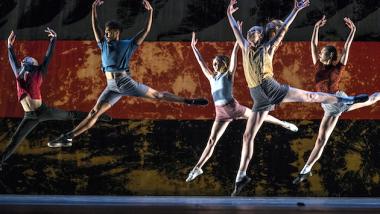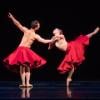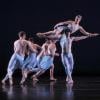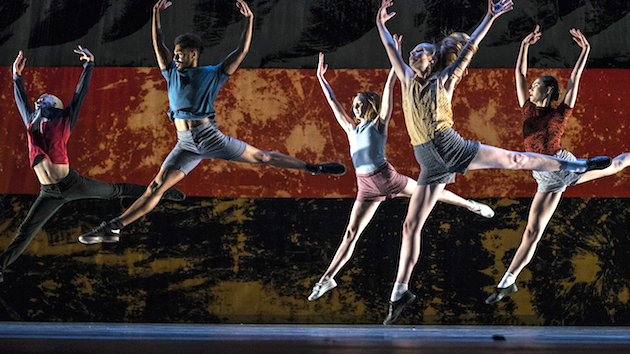
“Hearts and Arrows,” choreographed by Benjamin Millepied for his L.A. Dance Project, has the all the earmarks of what one would hope for from such a superb company of dancers, led by such an ambitious artistic director. Sadly, the high bar it set came at the conclusion of the company’s performance, presented by Stanford Live Saturday night at Memorial Auditorium.
Preceding it was an unconvincing little pastiche, Murder Ballades, choreographed by the superb young choreographer Justin Peck — in 2013. If it was ever worthy of him, it isn’t any more. But the six dancers, in beachy playclothes, gave it their all. The name dancer among them was Janie Taylor, a gorgeous veteran of the Houston Ballet as well as the New York City Ballet, setting a generous tone of SoCal cheeriness. Bryce Dessner’s music, played by Eighth Blackbird and derived, it said on the program, from folk songs (murder ballades, if you please) of the ’30s and ’40s, was far too friendly to feel murderous.
That was followed by the more interesting Second Quartet, choreographed by Noé Soulier to an awesome percussion score by Tom de Cock and the Ictus Ensemble. It feels like mystery contact improvisation, with forces arising from nowhere and the four dancers virtuosically responding, rebelling, and recoiling to punches and pushes and pulls from who knows where — standing, sitting, lying down. Certainly it showcased them at their best, particularly the lone woman, Rachelle Rafailides, who dances with every fiber of her body. Eventually the piece feels a bit one-trick pony, despite Rafailides’s best efforts and those of Aaron Carr, David Adrian Freeland Jr., and Nathan Makolandra.
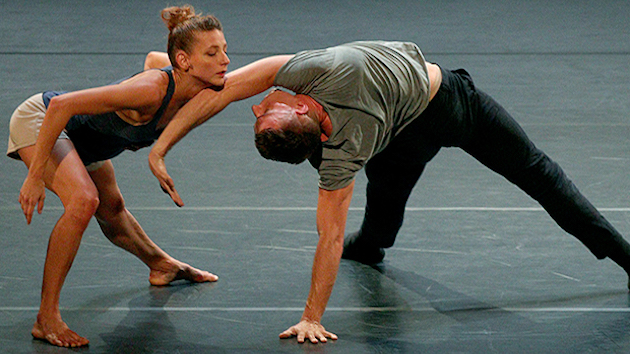
“Hearts and Arrows,” one section of Millepied’s Gems trilogy, is part of his sorta-riff on the “Diamonds” section of George Balanchine’s fabled Jewels for his New York City Ballet (it has the Van Cleef and Arpels commercial tie-in, just as Jewels did). But the Millepied piece doesn’t even make a gesture toward evoking images of the gems themselves. You will not see a gem on the stage, nor will you see any brilliant white costumes suggesting the shine and pulse of diamonds. Similarly, the other sections (left at home), do not evoke Emeralds or Rubies, to name the other sections of the Balanchine work, which had fake stones as an intrinsic part of the décor. So it’s Gems without the gems. The title must be wishful thinking: that each portion of the ballet will be, in and of itself, a gem of a more contemporary kind.
“Hearts & Arrows” has black and silverish squares on its short and perky costumes instead of white tulle classicism; shoes and socks instead of point shoes; the thrumming of the Philip Glass String Quartet No. 3 (Mishima), not Tchaikovsky. The bare stage is devoid of crystalline chandeliers; the lights are naked, the backstage walls visible. As for the theme, Millepied said it’s an “emotional journey” with a “strong and hopeful sense of lasting love and community amidst the uncertainty in which we live.”
In “Hearts and Arrows,” each move and interaction by the eight dancers (five men, three women) has a focus, offers a vignette. The moments are enticing and brief but each somehow pays off. The relationships flow, one into another; lifts and turns for a cluster of dancers segue flawlessly into a pas de deux, then a formation as for a country reel. One woman, once secure in the folksiness of her group, suddenly is abandoned by the others; in effect, left hanging. It’s funny and sad and the moment rushes by and we’re seeing an acrobatic interlude, followed quickly by interdependent duos resting and relying on each others’ necks, shoulders, and backs. The whole thing commands attention in a way that feels personal and even ingratiating.
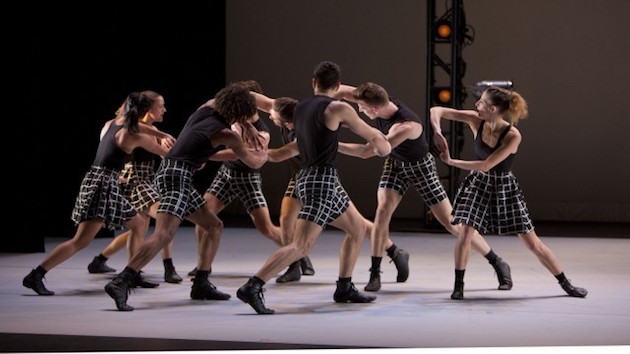
We have arrived at a cultural era when selling a lifestyle is as important as selling the art itself. It appears, for good or ill, to be working. Millepied, from France and New York (and L.A.!) has a good eye when it comes to choosing dancers, ample artistry to land him briefly in the artistic director’s seat at the Paris Opera Ballet (he left, surprising everyone), and a fluency that served him well when he choreographed the movie The Black Swan, for which Natalie Portman, his now-wife, won the best-actress Oscar.

The point, at least in part, is that Millepied’s cultivation of links to fashion, celebrity, and power is as important to the success of his nascent troupe as the artistry. Rare is the young American company that can score as many high-visibility, international engagements and residencies as Millepied’s.
The L.A. Dance Project looks and feels very L.A. It’s got flash and style — Southern California style. Its stunning dancers look designed to please, but their quality, honed at multiple troupes and in multiple genres, bespeaks a welcome sense of unity.
Nobody can say that the City Ballet was or is a purely artistic venture; it takes money to keep any company going, and the hit Jewels, like Balanchine’s less-than-successful PAMMTGG (after the slogan “Pan Am Makes the Going Great,” a tie-in with the airline), brought in capital and curiosity.
Quests for sponsorships, commercial tie-ins, and prestige remain vital to any company. But the level of extra-artistic interlock, if you will, is miles beyond what it was in earlier times. New media has delivered new audiences, new opportunities, a new sense of urgency. Newer, nimbler, less tradition-bound companies can act more quickly to leverage those.
Millepied seems to be saying that his generation is grappling with a new kind of uncertainty. That’s arguable. Jewels (1967) went forward in a time of uncertainty: Vietnam, civil rights, and soon, the assassinations of Robert Kennedy and Martin Luther King. On the other hand, if we just look at Jewels, Balanchine showed us gemlike, multifaceted, constantly changing choreography, rather than swiftly shifting social interaction. And that felt like more than enough.
Even so, Millepied’s 2014 “Hearts & Arrows” indicates there’s more to see from this company than the other two ballets on board Saturday night. The beauty and continuous energy of the dancers, the way they connected with their audience, is certainly persuasive of the sense of community Millepied mentioned. It would be good to see the company in his own, more recent work.

